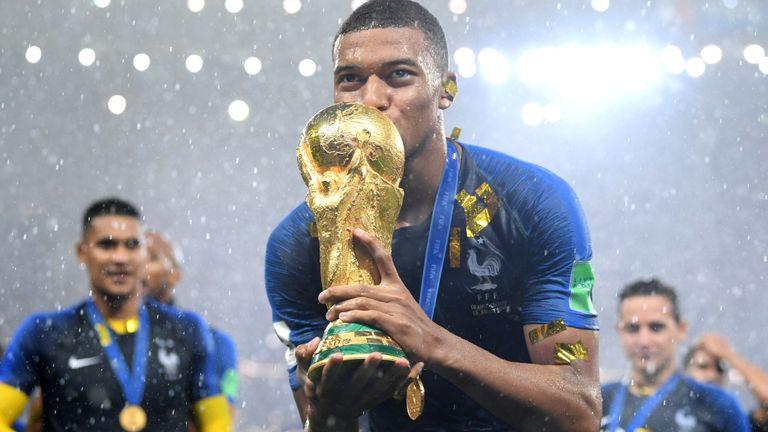
Training Guide FM19: the next Generation
In my recent post about my Golden Generation at Red Bull Leipzig, I’m still churning through seasons at the club. I’m trying to make some progress but as a result of my endeavors, I’ve started to get to grips with the new training system implemented in this year’s Football Manager. Training guide FM19.

After winning the league in my second season, we’re looking confident to challenge for the title again. After losing Marcel Sabitzer and Péter Gulácsi we signed Jadon Sancho, Julian Weigl, Timo Horn and Serge Gnabry to pad out the squad for a good cup or champions league run.
As with lots of creative or inventory management games (in this case footballers) there is a ‘golden rule’ for success:
Input = Output
What I mean by this is that if you decide to plug in a tactic from a content creator, leave your assistant to run training and tactics and just meander through the season, you’ll probably do alright. Perhaps you’ll do a bit better than expected or maybe a bit worse, but you’ll do alright.
If however you decide to fully invest into the save and create a detailed tactic, scour nation after nation. Find the perfect player and micro-manage your imaginary staff to an infinite degree. You might find that results will tend to go your way, and the payoff is ecstatic. You might still do worse than if you coasted through, but you can safely say it was you doing it and can be proud of the commitment.
Training is definitely one of these ‘Input = Output’ scenarios. This year training was overhauled and is now heavily integrated into the tactics system, with the two overlapping constantly. Here are some top tips to bridge the gap and make more of the training features without being completely in over your head.
Step 1: Build your tactic, then your training.
We have enough guides on this site for specific tactics and roles so I’ll throw a few of them in here for reference.
- Our recent guide by CrusaderTsar on the Shadow Striker role
- How to defend with a high line
- The best 4-4-2 diamond narrow tactic you’ll ever see
If you’d like an idea of how to set up for a smaller side without the exact tactic.
IMPROVE THE ODDS – GUIDE TO A WINNING TACTIC FOR THE UNDERDOG
You need to make sure your tactic and style of play is firmly set in place and build your training set-up around that. If you want players working hard (high pressing or counter attacking) you’ll need to up the intensity earlier. On the other hand if you are playing a low intensity style like tiki-taka you’ll focus more on team cohesion.
Despite your efforts, if the tactic isn’t working that’s fine you should always tinker. However try and keep the basis and ideology of the tactic fairly consistent for the season.
Step 2: Identify your key youngsters and promote them to the first team.
A great TL:DR piece on AddictedToFM sums it up perfectly:
- Identify 22 players for your main squad and decide on your tactical system
- Identify 4-6 players from your U19 team and promote them to the first team
- Based on your tactical system decide who should be in the Attacking Unit and Defending Units
- Plan who your set piece takers will be
- Create Mentoring Groups led by a Team Leader with the right personality, add no more than 3 players per leader.
- In case you are unsure, hire an Assistant Manager with good tactical knowledge and/or technical training in tactics/defending or tactics/attacking. Have this ass man assign groups
Mentoring has changed and now works differently, as a result you can’t just pair up a youngster and veteran and have them sit at lunch together on Tuesdays. Players need to be regularly training together to influence each other so they must be in the same squad. Don’t forget to make youngsters available for the Under 19’s. This keep up sharpness and fitness when they aren’t breaking the first team. An example of a set of mentoring groups is as follows:

There is a lot going on here so let me explain:
- Here are three example mentoring groups (CM’s, Wingers and Strikers) try and sort mentoring groups by position
- Each group has one of my three ‘team leaders‘ (check the hierarchy page under dynamics). They are older than all the other members of the group
- Social group is less important, but obviously having players who are already friends make it easier and faster for players to pick up traits. Having similarly personality traits also helps with this.
- The first group has one much older player (28) compared to an average of under 20 for the remaining three players. The personalities are a lot more likely to be influenced by the older player (e.g. Perfectionist, one of the best personalities for a player to have)
- The other two groups have Team leaders of a similar age but larger stature, its the first-teamer helping some of the rotation options with PPM’s (Player Preferred Moves). I’m hoping some of them will pick up some key ones including Bruma and Werner’s trait Knock Ball Past Opponent.
- If you are struggling, your assistant can assign groups as well that might even be better but it doesn’t hurt to try! This game is about learning, you don’t have to be perfect on your first try.
Step 3: Individual Training; The Lottery Game

Some times (in the case above) players will really take to training. They’ll improve drastically in key areas over a short space of time. For example, my 17 year old has improved lots of areas in just a few early months in the season. With a low risk of injury, he play’s Under 19 matches and sit on the bench in case anything happens in the first team.

However that doesn’t always work; VDB was playing in Central Midfield last season. However Weigl and Gnabry coming in I wanted to try pushing him forward as a more creative enganche or playmaker. With 1 goal in 30 league games last season I decided to train his shooting a tad to see if that would improve his outlet and to my surprise it did. 4 goals in 6 games so far has already seen a huge improvement. However he is clearly unhappy with the training as its not helping, as well as being a high risk of injury due to the individual training focus and first team football. Using the ‘Rest’ option after matches might be appropriate to avoid any serious injuries.
When choosing whether to a) assign a player individual training and b) which additional focus to give him: always ask your assistant. They are usually fairly reliable and are more in touch with the likelihood of injuries than we all are.
Step 4: The Crazy Calendar of Carnage

Your assistant will more than happily do this all for you and you won’t really notice a difference. If you want to commit to half of this article, I wouldn’t touch the calendar. But if you’re as crazy as I am… welcome to a living hell. Imagine planning a weekly training schedule for little imaginary computer people running around on a screen kicking an equally imaginary football? Bizarre.
The weekly planner is splits each day into 3 parts. Each part can be changed to suit what you feel your team is lacking. Fitness is primarily focused on early in pre-season. I’d suggest tactical work early on with some set-piece or team cohesion sprinkled in. Throughout the season you can adjust depending on how the season goes.
I rarely link guides to other Football Manager sites. For me to cover this in depth would take another few articles. Its been done by Addicted to FM and I’d recommend a similar guide out there if you’re still wanting more.
FM Training Guide – Addicted To FM

Your day is split into two sessions (presumably morning and afternoon). Followed by an extra session for specific events like match previews or extra recovery sessions.
The great new feature is that when the team is training on ‘attacking movement’ for example; your defenders won’t be training their shooting but actually defending against the attackers. Feel free to click on a few of the sessions and see what they do. It shows how each group of players is involved and what they benefit from each session. This allows you to plan your week with every group in mind.
There are other sections of the training set-up that I haven’t covered in this article such as setting up units and choosing appropriate coaches but for now, we’ll leave it there.
More articles you might enjoy
- FM19 | MONEYBALL | PART 3
- FM STATS LAB: DECISIONS, DECISIONS, DECISIONS
- SARRIBALL AT JUVENTUS | THE FIRST SEASON